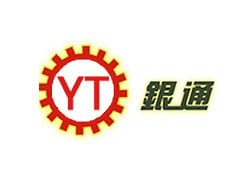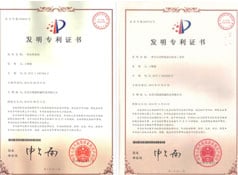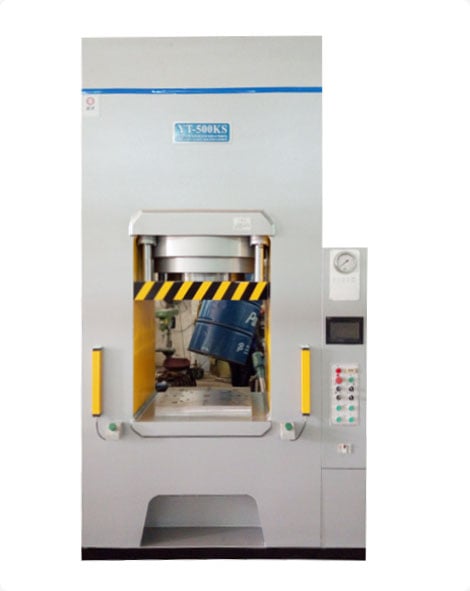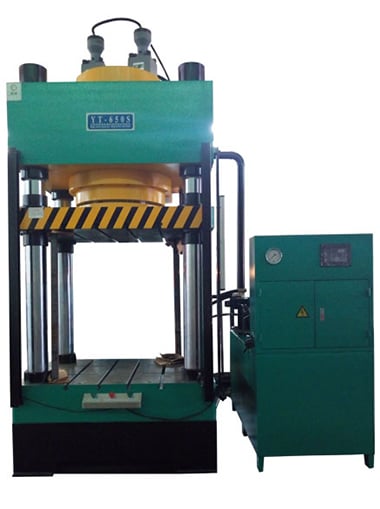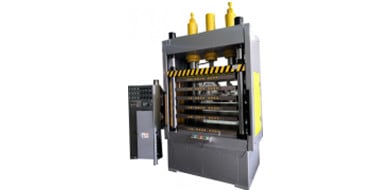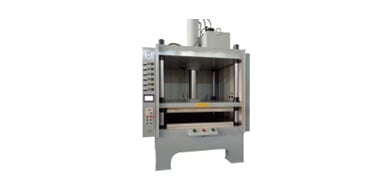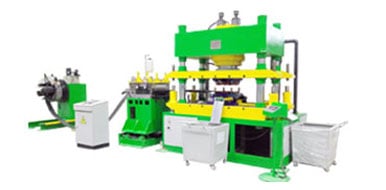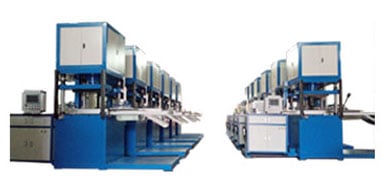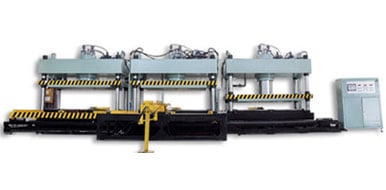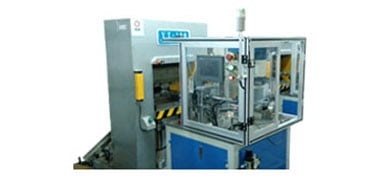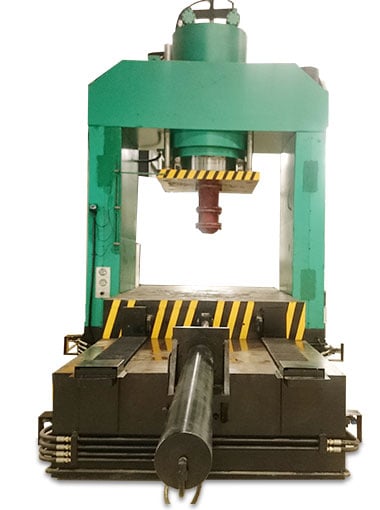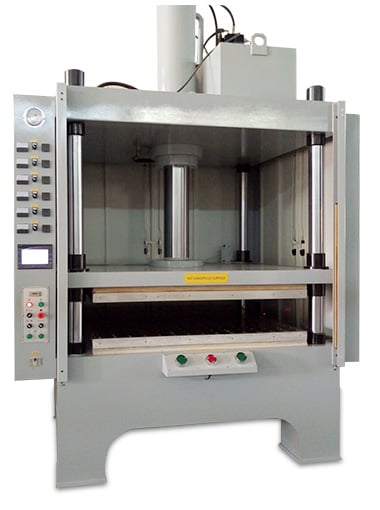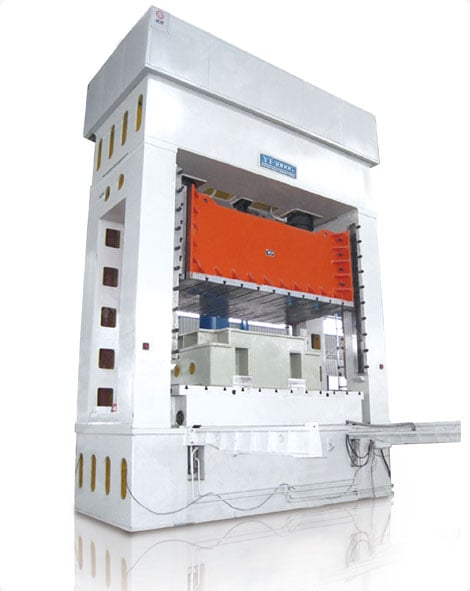What Is a Hydraulic Press Machine?
time:2023-06-06 views:(点击 1,592 次)Hydraulic press machines generate mechanical power by applying force on an object, using liquid medium such as oil as its source. Because this liquid medium is incompressible, any force applied to any one part will spread throughout its entirety and create mechanical power.
Hydraulic cylinders serve as the power source for machinery, consisting of piston rod and ram. It converts fluid power into pressure.
Compression
Hydraulic presses are great tools for applications requiring high levels of pressure, including compressing materials such as metal and plastics. These presses have many industrial uses including stamping and forming sheet metal, extruding plastic pipe, bending oversized diameter tubing and assembling components and parts. A hydraulic press can help increase output while increasing quality in your work.
As well as exerting high forces, presses are also capable of staying under pressure for varied lengths of time and varying ram speed to produce consistent pressure across large areas - essential features in many compression molding applications. Furthermore, these machines can operate at lower pressure settings to protect materials or other parts from being damaged by overstretching or stress fracture.
Hydraulic presses operate under Pascal's law, which stipulates that pressure applied to an object remains uniform throughout its journey through a hydraulic system. Since liquids such as oil are typically used to transfer and distribute pressure throughout their circulation systems, hydraulic systems can generate incredible force with minimal energy expenditure.
Another key feature of a hydraulic press is its use of a load cell to measure force or weight being exerted on any given surface. The load cell converts mechanical pressure into electrical signals that can be read and monitored by its operator, giving more precise measurements of pressure applied to workpieces ensuring work is being completed at appropriate pressure levels.
To accurately gauge how much pressure is being applied to a workpiece, a hydraulic press must feature a load cell. A load cell acts as a transducer that converts mechanical pressure into electronic signals, helping ensure its quality and accuracy as it ensures it operates at its appropriate force level and prevents equipment damage as well as ensure employee safety.
Expansion
Hydraulic presses come in all sizes and forms, from table top models to massive ones that exert hundreds of tons of pressure. Hydraulic presses are widely used machines used for shaping, deforming and configuring metals of various kinds; as well as featuring prominently in forging, clinching, molding blanking punching deep drawing metal forming processes such as forging. Pascal's principle dictates that pressure in static fluid is distributed evenly in all directions allowing for equal pressure transmission across its entirety.
Hydraulic press machines employ two hydraulic oil-filled cylinders connected by pistons. Energy from one servo-hydraulic cylinder transfers to a larger master hydraulic cylinder where its pressure can then be transferred directly onto press plates and other components, enabling them to bend, press, and shape materials.
Although hydraulic presses can be extremely powerful, their minimal maintenance needs make them easy to keep running well. Since there are fewer moving parts that are all covered with pressurized oil lubricant flow, their lower breakdown risk makes this machine ideal.
Hydraulic systems do require some regular care and attention, particularly the hydraulic accumulator which stores high-pressure liquid and acts as a connector between pumps and rams. To maintain optimal operation of this part of the system, its level must remain at an ideal level to avoid overpressurizing rams or leakage issues.
An additional component of a hydraulic press machine is its safety door, relief valve, manual control valve and electrical control box. The safety door serves to protect operators from dangerously high levels of pressure while relieving excess pressure that builds up in cylinders through relief valves. A manual control valve blocks or diverts oil flow so as to adjust force applied by press plates while an electrical control box provides multiple control options via wiring connections and circuit connections that allow it to function as either manual, automatic or remote-controlled unit.
Powder Compaction
Hydraulic press machines with powder compacting capabilities have many applications. Their ability to compact granular or powdered materials into desired shapes, sizes, and densities translates to reduced manufacturing costs and time as well as less raw material wastes - known as compression molding this production technique can produce various products including metallic, ceramic, composites as well as PTFE products.
A hydraulic press operates according to Pascal's Law to exert pressure onto a fluid in a confined environment, usually oil. As soon as force is applied at one location, its effects are quickly distributed throughout the liquid without loss in power or precision.
An hydraulic press machine features an oil tank to store and deliver oil to its cylinders, connected to a motor which generates mechanical power to help create pressure on pressing plates. A pressure gauge and relief valve can also be set for protection from excessive hydraulic pressure.
Hydraulic presses can also be used to form various metal components. They're particularly helpful for producing metal matrix composites combining metals with another material for increased strength and durability. MMCs can be found in numerous medical and industrial applications, from orthopaedic implants to surgical tools. Their production requires using a hydraulic press to compress powdered metal into molds before heat treating for heat treatment of final product. Hydraulic presses can also be used for material testing, creating test substances used in evaluating new materials' performance and helping manufacturers reduce manufacturing costs and time; testing also reduces contamination risks while increasing accuracy.
FTIR Spectroscopy
Hydraulic press machines use levers and other mechanical devices to multiply the force exerted by users' hands to make pressing materials easier. This works due to Pascal's Law, which states that any pressure applied at one point will be transmitted throughout an incompressible fluid such as oil used in hydraulic presses.
A typical hydraulic press uses a hydraulic pump that pumps oil into a cylinder, creating hydraulic pressure. A hydraulic accumulator stores this high-pressure fluid, keeping pressure constant when connected to the pump; when activated by activating the ram, this pressure is released so as to compress and shape materials more effectively.
Other parts of a hydraulic press machine include a safety door to keep pressure from damaging the ram. Furthermore, its hydraulic pump features a manual control valve which allows users to customize how much pressure is applied by the ram and create a precise press regardless of material differences.
Numerous industries rely on hydraulic press machines for part production and fabrication, from steel production to assembly of complex electronic components. Only using such machinery will guarantee proper assembly without any defects or damage occurring during assembly.
Hydraulic press machines are widely utilized in the construction industry for building skyscrapers, warehouses and manufacturing facilities. A hydraulic press is necessary to produce concrete for these structures as well as testing its tensile strength.
Hydraulic presses can crush a variety of objects, from bowling balls and soda cans to plastic toys and plastic toys. Because these presses can crush so many different materials so quickly, their use has become popular on YouTube; people upload videos showing their attempts at breaking various objects with hydraulic presses; some videos have gone viral - the Hydraulic Press Channel currently boasts over 3 million subscribers!
Link to this article: https://www.ihydraulicpress.com/yn/3553.html
Hot Articles
-
The Hydraulic Press – Watch Lauri Vuohensilta Smash a Box
Hydraulic presses are an indispensable addition to any workshop, providing flattening and crushing samples, straightening bent metal pieces, as we……
-
What Is a Hydraulic Press Used For in the Rubber Industry?
Hydraulic presses use fluid pressure to push a cylinder at an adjustable force. They can compress, assemble, draw, punch, trim, stretch, stamp and f……
-
What is a Hydraulic Press Used For in Metalworking?
A hydraulic press works by applying pressure to a liquid medium such as oil. This type of press operates according to Pascal’s principle and i……
-
Blaise Pascal and the Hydraulic Press
Blaise Pascal was a French mathematician, physicist and philosopher renowned for his contributions in mathematics, physics and theology. Additiona……
-
What Happened to Hydraulic Press Channel?
Vuohensilta operates a family machining business using various machines such as hydraulic presses. Millions of viewers follow his YouTube channel ……
-
The History of Hydraulic Presses
Hydraulic presses have a long and distinguished history in manufacturing. They remain essential components that keep industries running smoothly and……
-
What Is a Hydraulic Press Used For in the Automotive Industry?
Hydraulic presses are machines that utilize fluid pressure to exert force on a workpiece. A pump pushes hydraulic oil into a cylinder, where it then……
-

Hydraulic Press For Knife Making
Hydraulic Press For Knife Making Hydraulic presses are indispensable tools for many metalworking tasks. ,and the Hydraulic Press For Knife Making is……
Latest News
-
What is Inside Hydraulic Presses?
A hydraulic press is a highly-versatile piece of equipment, used across numerous industrial settings from scrap baling to configuring metal into p……
-
How Does a Hydraulic Press Work?
Hydraulic presses operate by applying Pascal’s law, using incompressible fluid (such as oil) as the conduit through which to transmit force. A……
-
What Do I Need to Build a Hydraulic Press?
A hydraulic press is an invaluable machine that utilizes liquid to generate pressure, making it suitable for many tasks such as forming, stamping,……
-
Where to Buy Small Hydraulic Press Machine
Home and auto shops alike use hydraulic presses for straightening and bending metal, replacing bearings, stamping parts, creasing them as needed a……
-
What Is a Hydraulic Press Used For in the Military?
Hydraulic presses use fluid pressure as their driving force. The most basic design involves two pistons of equal size connected by a tube filled wit……
-
Hydraulic Presses – What Are They?
Hydraulic presses are machines that utilize pressure and fluid to shape materials into desired shapes. They’re employed in many fields such as……
-
What is the Difference Between a Hydraulic Press and an Injection Molding Machine?
Hydraulic presses are plastic injection molding machines that utilize hydraulic cylinders to clamp two mold halves together. Once filled with melted……
-
What Is a Hydraulic Press Capacity?
Hydraulic presses are an indispensable element of production and assembly processes, offering great versatility while helping minimize their footpri……
